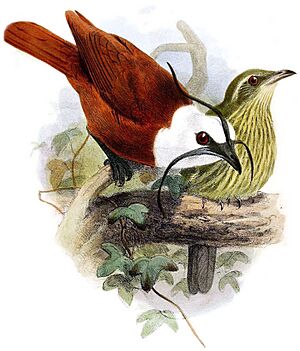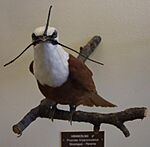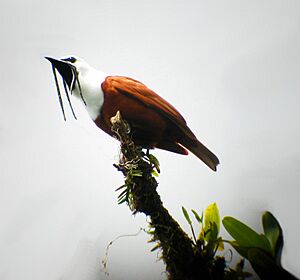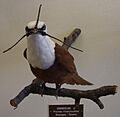Three-wattled bellbird facts for kids
Quick facts for kids Three-wattled bellbird |
|
|---|---|
 |
|
| Male (left) and female (right) | |
| Conservation status | |
| Scientific classification | |
| Genus: |
Procnias
|
| Species: |
tricarunculatus
|
 |
|
| Synonyms | |
|
Procnias tricarunculata |
|
The three-wattled bellbird (Procnias tricarunculatus) is a special bird from Central America. It is a migratory bird, meaning it travels long distances. This bird belongs to the cotinga family. Male and female bellbirds look very different from each other.
The male bellbird has a bright white head and throat. The rest of its body is a rich chestnut brown color. Three long, thin, black skin flaps, called wattles, hang from the base of his beak. He uses these wattles when he wants to impress a female. The female bellbird is mostly olive green. She has yellowish stripes on her belly and a yellow area near her tail.
These bellbirds build their nests in the mountains of Costa Rica. Later, they fly to western Honduras, Nicaragua, and Panama. The male bellbird makes a very loud, clear, bell-like sound. Because these birds are shy, you are more likely to hear them than see them. Sadly, their numbers are decreasing. The International Union for Conservation of Nature says they are a "vulnerable" species.
Contents
What Does the Three-Wattled Bellbird Look Like?
The three-wattled bellbird is one of four types of bellbirds found in Central and South America. This bird is about 25 to 30 centimeters (10 to 12 inches) long. The male bird has a chestnut-brown body, tail, and wings. His head, neck, and upper chest are white. He also has a black ring around his eye, a black stripe near his eye, and a black beak.
The bird gets its name from the three worm-like wattles that hang from its beak. These wattles can grow up to 10 centimeters (4 inches) long. They get longer when the male sings or interacts with other birds. The wattles are soft and floppy, even when they are extended. The male can shake them, but they mostly hang straight down. Their exact purpose is still a bit of a mystery!
Female bellbirds are smaller and not as colorful. They are mostly olive green with yellow stripes on their underside. Their tail area is pure yellow, and they do not have wattles. Females blend in well with the forest around them. This helps them hide their nests from animals that might try to eat their eggs or chicks. It is very hard to find their nests. As of 2019, only six nests had been found in the Monteverde area of Costa Rica.
Young male bellbirds look like females until they are about 7 years old. As they get older, their green and brown feathers are replaced. They slowly grow their bright white and copper-colored feathers. They start growing their wattles when they are 1 to 2 years old. The wattles continue to grow throughout the male bird's entire life.
Where Do Three-Wattled Bellbirds Live?
The three-wattled bellbird is known for its very unique and loud calls. These birds live from western Honduras all the way south to eastern Panama. Bellbirds usually breed in the highlands of Costa Rica. They prefer the cool, misty cloud forests from March to September. After breeding, they fly down to lower areas, like mangroves, for the rest of the year.
How Do Bellbirds Find a Mate?
The bellbird has a very unusual way of finding a mate. Male birds will quietly sneak up behind females. The females are usually sitting on high branches. When the male is close, he opens his mouth very wide, almost 180 degrees. Then, he makes his famous "bonk" sound right into the female's ear! This loud sound can sometimes make the female fall off her branch.
They might repeat this special dance a few times. After their courtship is finished, the female leaves. She will then build a nest and raise her chicks all by herself.
What Do Bellbirds Eat?
The three-wattled bellbird eats only fruit. This means they are completely frugivorous. They especially love to eat fruits from trees in the Lauraceae family. Avocados are also part of this plant family.
Bellbirds play a very important role in spreading seeds. They swallow the fruits whole. Then, they spit out the seeds they cannot digest. They drop these seeds in open areas under the branches where they sing. This helps new trees grow. In fact, it almost doubles the chance that a new seedling will survive!
The Bellbird's Amazing Song
Because these birds are so secretive, people often only know they are around because of their loud, bell-like call. When you are close to them in Costa Rica, you can hear a complex three-part song. The "bonk" sound is what gives the bird its name. This hollow, woody "bonk" is thought to be one of the loudest bird calls on Earth. Humans can hear it from over 0.5 miles (0.8 kilometers) away!
The song sounds a bit different in Nicaragua and Panama. These songs also have a very loud note, but it is less like a bell. Sometimes, the song is a short "Heee-Ahhh." Some people have even said it sounds like microphone feedback!
A researcher named Donald Kroodsma studied recordings of bellbirds. He found something very interesting. Unlike most birds in its group, the three-wattled bellbird learns its song. Most birds are born knowing their song. But the bellbird's song changed over the years that it was recorded. This shows they can learn new sounds!
Why Are Bellbirds Vulnerable?
The number of three-wattled bellbirds is going down. This is mainly because their forest homes are being destroyed. The International Union for Conservation of Nature has said that their conservation status is "vulnerable". This means they are at risk of becoming endangered.
The Monteverde Institute in Costa Rica is working to help these birds. They have a program to plant new trees in the bellbird's natural habitat. They have planted over 250,000 trees of more than 140 different kinds. These trees are in an area called the Bellbird Biological Corridor. This helps connect the different habitats that many species, including the bellbird, need for their migrations.
Images for kids






